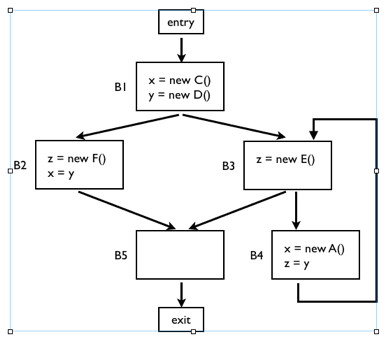Compilation Methods SS 2013 - Assignment 4
Kastens, Pfahler, 28. Mai 2013
Exercise 1 ( Data Flow Analysis Using a Type Lattice)
Consider the semi-lattice L for types of Slide C-2.24b:

L3 = L x L x L. The meet operation of
L is defined by:x meet y is the smallest common super-type of x and y.
The meet operation of L3 is obtained by applying that of L componentwise.
The partial order in L3 is defined by
(x1, x2, x3) <= (y1, y2, y3) iff x1<=y1 and x2<=y2 and x3<=y3.
- a)
- Fill in the missing items:
- (C, A, O) meet (D, C, F) = (_, _, _)
- (E, B, D) meet (D, C, D) = (_, _, _)
- (_, _, _) <= (C, B, O)
- (A, _, _) is not <= (_, B, _)
- (D, _, _) is not <= (_, O, _)
- b)
- DFA using L3:


- c)
- Use the following table to compute the In- and Out-values for each block
iteratively:

Exercise 2 ( Graphs in Compiler Analysis)
Consider the following kinds of directed graphs used for program analysis: control flow graphs, call graphs, and class hierarchy graphs. What does it mean for each of the kinds of graphs if ...
- a graph contains a cycle,
- the undirected graph which corresponds to a given graph is disconnected,
- a graph is a tree?(distinguish the cases whether the edges point to the root or to the leafs.

Exercise 3 (Call Graph)
Construct the context-insensitive call graph of the program:
int p1 = 0, p2 = 0, p3 = -1, p4 = 0;
void h() { p1++; }
void i() { g(); h(); }
void f() { if (p1<3) { h(); f(); } }
int g() { h(); if (p1<4) i(); return p1; }
int main()
{ int i;
for(i=0; i<3; i++)
{ if (p1)
{ do
{ f(); }
while (p2);
} else {
if (p3)
{ g();
} else {
while (p4)
{ g(); }
break;
} /* if */
f();
} /* if */
} /* for */
return p1;
}
Exercise 4 (Object Oriented Call Graphs)
- a)
- Draw the class hierarchy graph for the following program:
package packneu; abstract class E { int h() { return 9; } int z() { return 10; } int s() { return z(); } } class K extends E { int s() { return 0; } } class A extends E { int s() { return super.s() + 1; } } class B extends E { int b() { return 2 * p(); } int p() { return 3; } } class L extends B { int z() { return b(); } int p() { return h(); } } class Main { public static void main(String[] args) { E e; e = new A(); System.out.println(e.s()); e = new B(); System.out.println(e.s()); e = new L(); System.out.println(e.s()); } } - b)
- Write the call chains that are initiated by the three calls of println.
What does the program print?
- c)
- Our Java Bytecode analysis tool constructed the following call graph for
this program:

Add the missing class names to the method and constructor nodes.
- d)
- Find edges which could be eliminated by more powerful analysis methods (see Slide C-2.33).
Generiert mit Camelot | Probleme mit Camelot? | Geändert am: 13.06.2017


